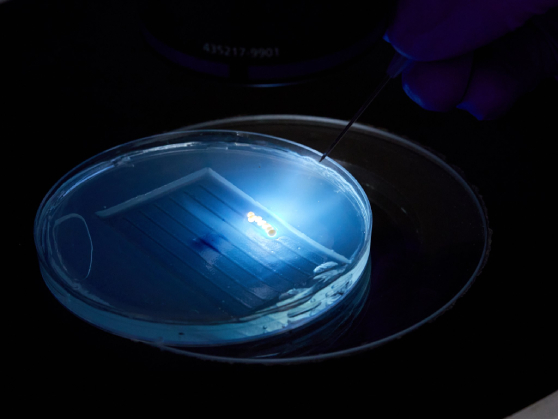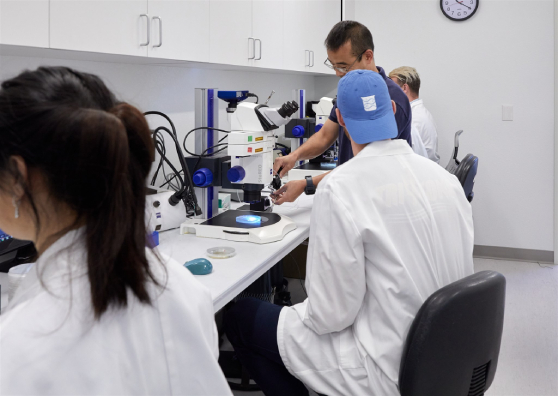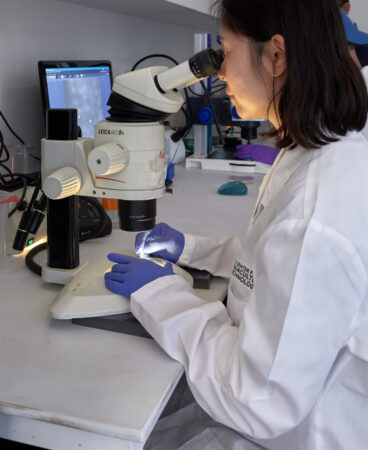
Brought to you by The Center for Aquaculture Technologies
GENOME EDITING – THE NEXT FRONTIER IN AQUACULTURE

March 1, 2024 in Features
By The Center for Aquaculture Technologies
 (Photo: The Center for Aquaculture Technologies)
(Photo: The Center for Aquaculture Technologies) Historical Context and the Need for Innovation in Aquaculture
Although there are historic records of aquaculture in China and Egypt from thousands of years ago, the domestication of farmed fish has a much shorter history than terrestrial farmed species. Despite its later start, aquaculture has made considerable progress, especially in selective breeding, matching the advancements in land animal farming. This progress results from investments in breeding strategies and the use of technology for data collection and analysis. Today’s breeding programs aim to enhance multiple traits at once, in various environments, using advanced statistical models and DNA markers to identify the best animals for breeding.
As the aquaculture sector continues to evolve, it relies increasingly on these advanced models and markers to refine traits such as growth rate and feed efficiency. Yet, the industry is confronted with inherent genetic limitations. Challenges such as the time between generations, the inheritability of desired traits, the intensity of selection processes, and the financial implications of assessing traits on a large scale highlight the urgent need for innovative approaches. These technological breakthroughs are critical, not just for the industry’s advancement but to fulfil the growing global necessity for a sustainable and nutritious food source.

(Photo: The Center for Aquaculture Technologies)
Introduction to Genome Editing (GE) and Its Potential
The early 2000s marked a significant milestone in genetics with the development of Genome Editing (GE), a method enabling scientists to precisely alter DNA sequences within organisms. This innovation arrived amid a genomics revolution, vastly improving our understanding of the relationship between genes, their expression, and traits important for breeding programs. GE’s ability to closely replicate natural genetic changes has the potential to significantly impact not just medical and biological research but also agriculture and aquaculture. It promises to enhance growth, increase disease resistance, improve environmental resilience, and address fundamental reproductive traits, making GE a critical tool for the future of aquaculture.
GE has occasionally been mistaken for transgenic technologies (GMO), a method of transferring genes between species — a process that does not typically occur naturally. This led to strict regulations in many countries. However, the fact that the genetic variations made by GE could have occurred naturally have started to change how it’s viewed, leading to its deregulation for breeding purposes in some regions. For example, Japan now produces GE fish in limited quantities within Recirculating Aquaculture Systems (RAS) to prevent them from mixing with wild populations. Brazil has lifted restrictions on GE for tilapia farming, and Australia has recently announced plans to deregulate GE as a breeding tool. This trend towards more relaxed regulations is expected to increase the adoption and innovation of GE, promoting more sustainable practices in aquaculture.
Benefits of GE in Commercial Aquaculture
The commercial aquaculture sector has shown interest in GE, recognizing its potential to significantly enhance various aspects of fish farming. This technology has the power to bring about substantial improvements in fish performance, particularly in areas where the relationship between genomic variations and traits are well-understood. Worldwide, both academic and commercial research teams are exploring how modifications in key genes could enhance traits such as growth rate, feed efficiency, fillet yield, disease resistance, coloration, and overall composition. Implementing GE to modify genes associated with these traits could lead to advancements that might take decades to achieve through conventional breeding methods. Among these potential improvements, perhaps the most transformative would be GE’s ability to manage sterility in aquaculture production.

(Photo: The Center for Aquaculture Technologies)
Controlling reproductive capabilities is a critical concern in fish farming, particularly because of the proximity of aquaculture operations to wild fish populations. The risk of farm-bred, gene edited fish escaping and potentially breeding with or outcompeting native species is a reasonable ecological concern.. Employing GE to induce sterility in farmed fish addresses this concern head-on, offering a path toward more sustainable aquaculture practices. This strategic use of GE not only enhances production efficiency but also aligns with broader environmental conservation goals, marking a pivotal step forward in the responsible expansion of aquaculture.
In addition, sterile fish typically have a performance advantage as energy resources are not diverted to reproduction but are instead directed toward growth. This results in improved growth, better feed efficiency, and higher filet quality. While other methods like triploidy have been employed to induce sterility, they often fall short of being 100% effective and can adversely affect fish welfare. Genome Editing (GE), on the other hand, offers a more reliable solution, capable of producing 100% sterile fish, enhancing both animal welfare, operational efficiency, and thoughtfulness toward environmental stewardship.
The evolution of farming is closely linked to the adoption of new technologies. The farming community pursues new technology to adapt fish to the farm environment to improve performance and welfare cost effectively. These improvements are not only crucial for the economic viability of fish farming but also for improving the overall health and robustness of farmed fish populations, making them more resilient to environmental stresses. The application of Genome Editing (GE) to enhance performance traits in fish farming should be conducted alongside the use of GE for inducing sterility. This strategy prevents aquaculture fish from interbreeding with wild populations or creating invasive species, while also protecting intellectual property rights.
The concept has been realized through initiatives such as the Sterility+™ platform developed by the Center for Aquaculture Technologies (CAT), which has already seen success with the editing of five finfish species in 2023. This platform allows for targeted modifications to DNA, aiming to improve performance while incorporating sterility into fish populations. This technology is tailored to each species’ unique reproductive biology and farming system requirements, with a focus on editing genes common across species to achieve desired outcomes. The use of Sterility+™ demonstrates the potential of GE to contribute to more responsible aquaculture practices by reducing the industry’s impact on the environment. Such developments in GE are pivotal in promoting more efficient methods within the sector.
Future Directions
The application of Genome Editing (GE) in aquaculture points towards a direction that balances trait improvement with environmental considerations. While the initial commercial edits are likely to involve genes with known effects on sterility and performance, R&D in genomics will reveal genes that affect other traits including welfare and health.
Collaboration between research organizations like The Center for Aquaculture Technologies (CAT) and fish breeders is essential. It ensures that the evolution of GE techniques is in line with the aquaculture industry’s goals for sustainable and responsible growth, carefully balancing economic
Advertisement
- Introducing BarAlgae : Your Premium Microalgae Feed Solution for Hatcheries
- Advantages of NFT Vaccination Machines